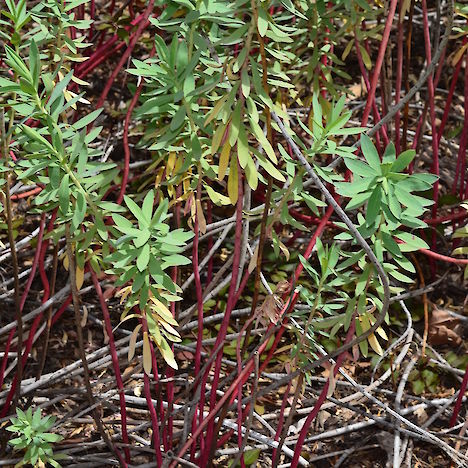Threat category:
At Risk: Declining?Regions:
Northland, Auckland, Waikato, Bay of Plenty, Gisborne, Hawkes Bay, Manawatu-Wanganui, Taranaki, Wellington, Nelson-Tasman, Marlborough, Westcoast, Canterbury, Otago, SouthlandDistribution:
North Island and South Island
Key Features
- A perennial herb of coastal sand dunes with many erect stems to 1 m tall, arising from creeping stems. Blue-green leaves up to 12 cm long are arranged radially on the erect stems, which contain a milky juice. Small inflorescences are produced near the stem tips, each surrounded by a red cup-like structure. Fruits are pendulous, green at first but becoming brown as they ripen.
Distribution and Habitat
- Coastal throughout, but becoming sporadic. The main habitat is sand dunes but shore spurge also occurs on coastal banks, rocky places, gravel and seepages near the shore.
Threats
- Habitat modification and loss.
- Trampling and browse by stock.
- Competition from taller vegetation.
- Coastal development, road widening and forestry.
Management Opportunities
- Survey for new locations.
- Mark known sites.
- Protection of habitat.
- Exclude stock.
- Collect and propagate seed for re-establishment in appropriate sites.
- Ensure that forest owners in coastal areas are aware of potential habitats and can recognise the species.
Monitoring Options
- Check existing populations annually.
- Report new locations to DOC and NZPCN.
Further Information and Support
- New Zealand Plant Conservation Network (NZPCN). http://www.nzpcn.org.nz
- References
- Wilson & Given (1989). Threatened plants of New Zealand. DSIR Publishing, Wellington.
- Peter de Lange, Peter Heenan, David Norton, Jeremy Rolfe and John Sawyer (2010). Threatened Plants of New Zealand. Canterbury University Press, Christchurch. 472 pp.




